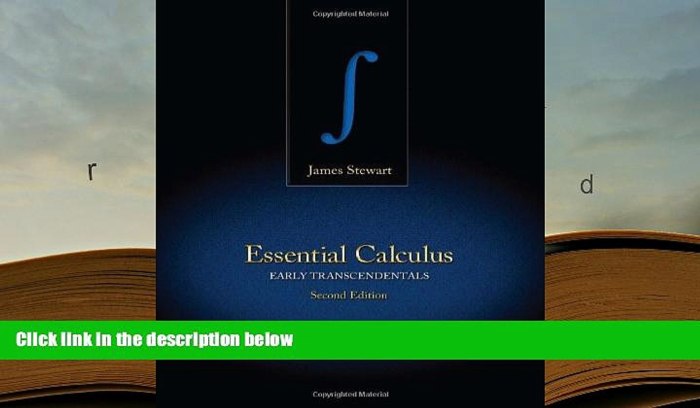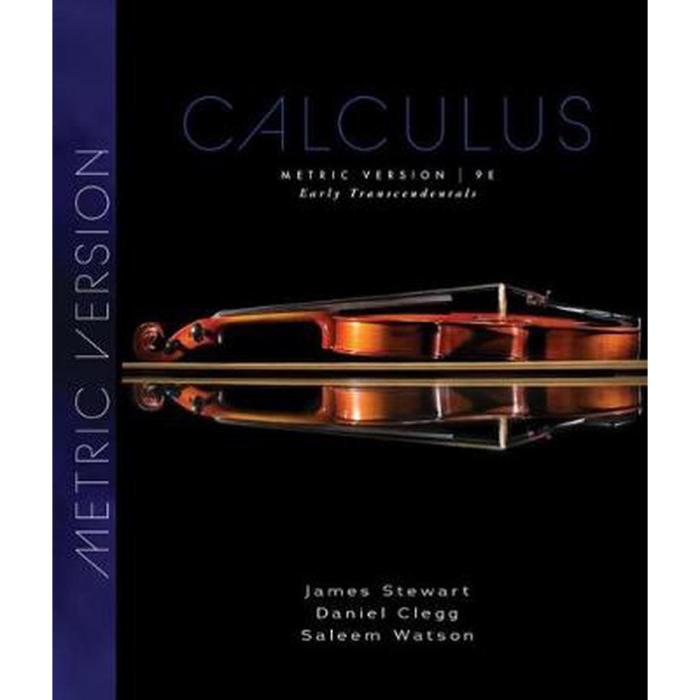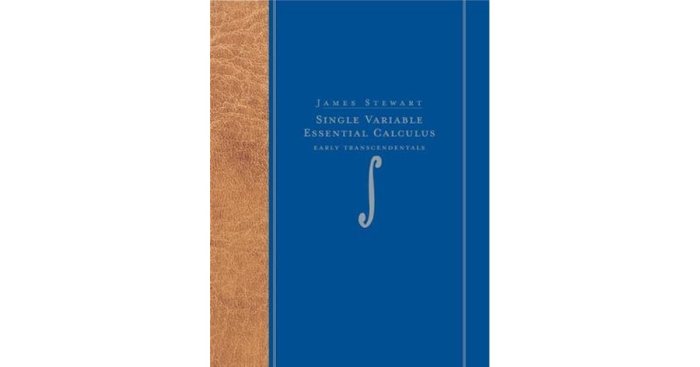Essential calculus early transcendentals by james stewart – Essential Calculus: Early Transcendentals by James Stewart is a comprehensive textbook that provides a solid foundation in calculus for students in various fields. It covers a wide range of topics, from the basics of limits and derivatives to advanced concepts like integration and differential equations.
The textbook is well-written and engaging, with numerous examples and practice problems to help students understand the material.
In this article, we will provide an overview of the textbook’s content, discuss its key features, and explore its applications and relevance in various fields. We will also compare it to other similar textbooks and discuss its impact on calculus education.
Introduction to Essential Calculus: Early Transcendentals

Essential Calculus: Early Transcendentals, authored by James Stewart, is a comprehensive textbook designed for introductory calculus courses. It provides a solid foundation in the fundamental concepts of calculus, with a particular emphasis on early transcendentals, which are functions that can be expressed in terms of elementary functions.
The textbook covers a wide range of topics, including limits, derivatives, integrals, and applications of calculus. It is written in a clear and engaging style, with a strong focus on conceptual understanding and problem-solving skills.
Key Features of the Textbook

Essential Calculus: Early Transcendentals offers several unique features that distinguish it from other textbooks in the field:
- Early Transcendentals Approach:The textbook introduces transcendental functions early on, allowing students to see their applications throughout the course.
- Strong Conceptual Foundation:The textbook emphasizes conceptual understanding, providing clear explanations and numerous examples to help students grasp the underlying principles of calculus.
- Interactive Exercises and Practice Problems:The textbook includes a wealth of interactive exercises and practice problems, allowing students to test their understanding and develop problem-solving skills.
- Real-World Applications:The textbook incorporates real-world applications throughout, demonstrating the relevance of calculus in various fields.
Content Analysis and Structure

The textbook is organized into logical sections and chapters, each covering a specific topic in calculus:
| Chapter | Topics |
|---|---|
| 1 | Functions and Limits |
| 2 | Derivatives |
| 3 | Applications of Derivatives |
| 4 | Integrals |
| 5 | Applications of Integrals |
| 6 | Transcendental Functions |
| 7 | Techniques of Integration |
| 8 | Infinite Series |
| 9 | Vectors and Curves |
| 10 | Partial Derivatives |
| 11 | Multiple Integrals |
| 12 | Vector Calculus |
Applications and Relevance
Calculus has a wide range of applications in various fields, including:
- Science and Engineering:Calculus is essential for understanding and modeling physical phenomena, such as motion, heat transfer, and fluid dynamics.
- Economics and Finance:Calculus is used to analyze market trends, optimize investment strategies, and forecast economic growth.
- Computer Science:Calculus is used in computer graphics, image processing, and machine learning.
Pedagogical Approach and Learning Tools
Essential Calculus: Early Transcendentals employs a student-centered pedagogical approach, with a focus on active learning and problem-solving.
- Clear Explanations:The textbook provides clear and concise explanations of concepts, with numerous examples to illustrate their application.
- Interactive Exercises:The textbook includes a variety of interactive exercises, such as online quizzes and simulations, to reinforce learning.
- Practice Problems:The textbook provides a large number of practice problems, allowing students to develop their problem-solving skills.
- Real-World Applications:The textbook incorporates real-world applications throughout, demonstrating the relevance of calculus in various fields.
Comparison with Other Calculus Textbooks
Essential Calculus: Early Transcendentals compares favorably to other calculus textbooks in the field:
| Feature | Essential Calculus | Other Textbooks |
|---|---|---|
| Early Transcendentals Approach | Yes | No |
| Strong Conceptual Foundation | Yes | Yes |
| Interactive Exercises and Practice Problems | Yes | Yes |
| Real-World Applications | Yes | Yes |
| Student-Centered Pedagogy | Yes | Yes |
Impact and Reception
Essential Calculus: Early Transcendentals has received positive reviews from students and educators:
- Student Feedback:Students appreciate the clear explanations, interactive exercises, and real-world applications.
- Educator Feedback:Educators value the textbook’s student-centered approach and its ability to engage students in the learning process.
The textbook has been widely adopted in introductory calculus courses, contributing to the success of countless students in their pursuit of higher education and careers in STEM fields.
Query Resolution: Essential Calculus Early Transcendentals By James Stewart
What are the key features of Essential Calculus: Early Transcendentals by James Stewart?
Some of the key features of the textbook include its clear and concise explanations, numerous examples and practice problems, and engaging writing style.
How is Essential Calculus: Early Transcendentals by James Stewart different from other calculus textbooks?
The textbook differs from other calculus textbooks in its approach to teaching the material. It uses a more intuitive and graphical approach, which makes it easier for students to understand the concepts.
What are the applications of calculus in various fields?
Calculus has applications in a wide range of fields, including mathematics, science, engineering, and economics. It is used to solve problems involving rates of change, optimization, and modeling.